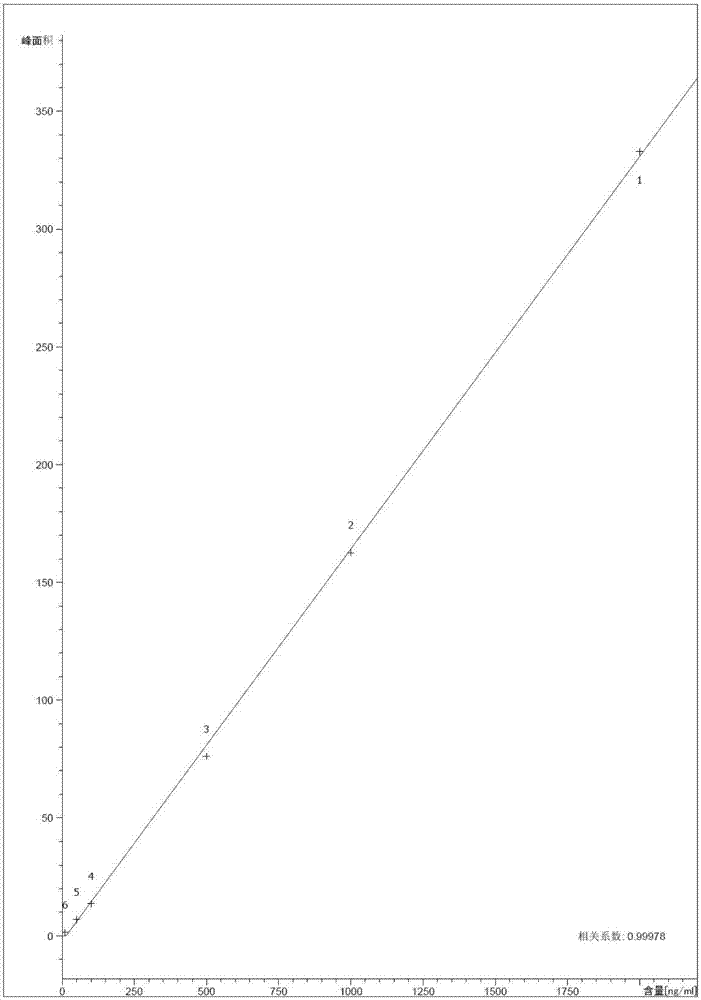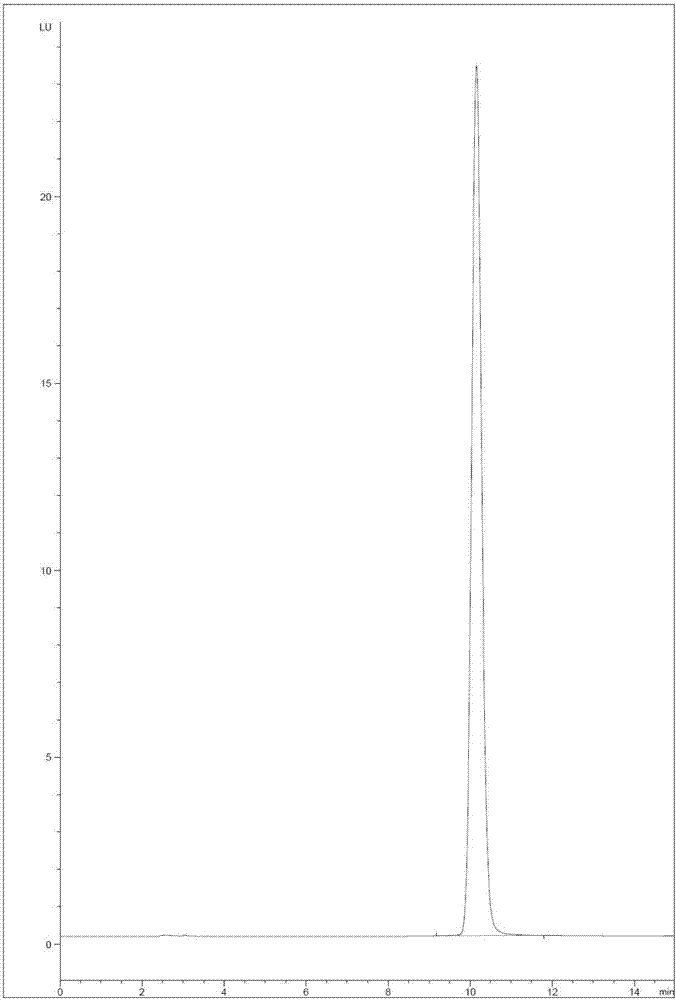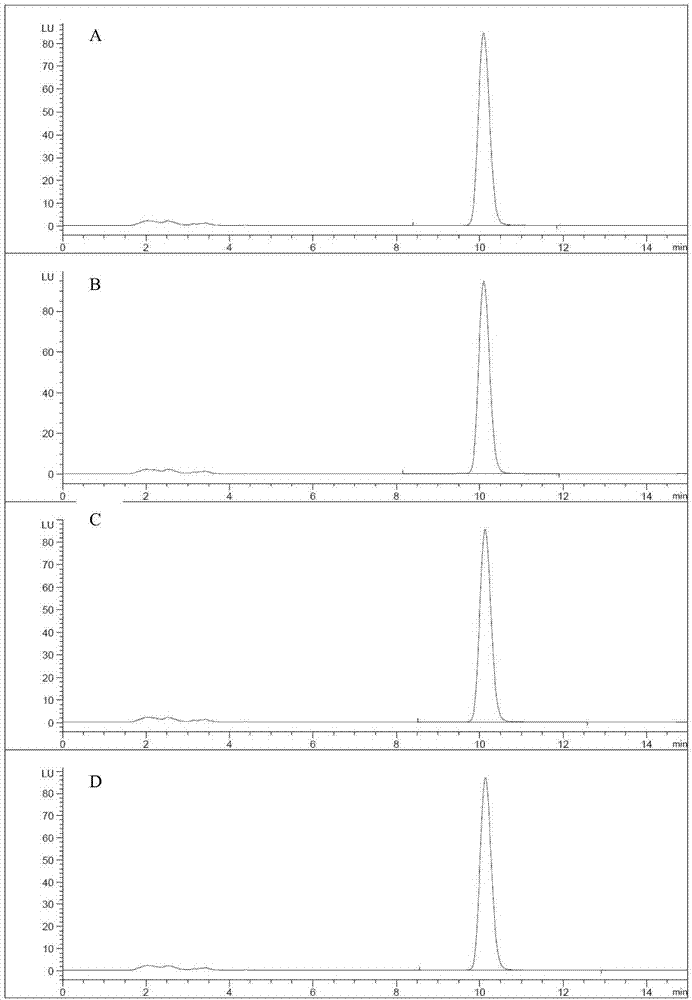Method for detecting citrinin toxin in monascus fermentation liquor
A fermented liquid and citrinin technology, applied in the field of detection, can solve the problems of complex purification methods and achieve the effects of simple extraction, high promotion and application value, and high efficiency
- Summary
- Abstract
- Description
- Claims
- Application Information
AI Technical Summary
Problems solved by technology
Method used
Image
Examples
Embodiment 1
[0032] Result shows: in 1mL sample, add citrinin toxin content theoretically to be respectively 200ng / mL, 100ng / mL, 50ng / mL, actual detection average value (being the actual detection of adding citrinin toxin standard substance in the following examples value) were 181.47ng / mL, 95.12ng / mL, and 55.48ng / mL, and the recoveries were 90.74%, 95.12%, and 110.96%, respectively. Example 1: Extraction of citrinin toxin and detection of citrinin toxin content in red yeast rice fermentation broth
[0033] The citrinin toxin in the original red yeast rice fermentation broth and the citrinin toxin standard addition sample were extracted from the red koji fermentation broth sample A respectively, and then quantitatively detected by HPLC. Specific steps are as follows:
[0034] 1. Extraction of citrinin toxin from the original red yeast rice fermentation broth
[0035] Use a pipette to accurately measure 1mL of fully mixed red yeast broth sample A, put it in a 10mL centrifuge tube, add 1mL...
Embodiment 2
[0044] Example 2, Extraction of citrinin toxin and detection of citrinin toxin content in red yeast rice fermented liquid
[0045] The citrinin toxin in the original red yeast rice fermentation broth and the citrinin standard added sample were extracted from the red koji fermentation broth sample B respectively, and then quantitatively detected by HPLC. Specific steps are as follows:
[0046] 1. Extraction of citrinin toxin from the original red yeast rice fermentation broth
[0047] Use a pipette to accurately measure 1mL of fully mixed red yeast broth sample B, put it in a 10mL centrifuge tube, add 1mL of chromatographic grade methanol, place it on a shaker at room temperature, shake vigorously at 200rpm for 60min, then transfer to a 2mL micro-injection bottle In the process, high performance liquid chromatography (HPLC) was used to analyze the sample liquid by high performance liquid chromatography, and the external standard method was used for quantitative data processing...
Embodiment 3
[0055] Example 3, Extraction of citrinin toxin and detection of citrinin toxin content in red yeast rice fermentation broth
[0056] The citrinin toxin in the original red yeast rice fermentation broth and the citrinin standard added sample C were extracted from the red koji fermentation broth sample C respectively, and then quantitatively detected by HPLC. Specific steps are as follows:
[0057] 1. Extraction of citrinin toxin from the original red yeast rice fermentation broth
[0058] Use a pipette to accurately measure 1mL of fully mixed red yeast broth sample C, put it in a 10mL centrifuge tube, add 1mL of chromatographic grade methanol, place it on a shaker at room temperature, shake vigorously at 200rpm for 60min, and then transfer it to a 2mL micro-injection bottle In the process, high performance liquid chromatography (HPLC) was used to analyze the sample liquid by high performance liquid chromatography, and the external standard method was used for quantitative data...
PUM
 Login to View More
Login to View More Abstract
Description
Claims
Application Information
 Login to View More
Login to View More - R&D
- Intellectual Property
- Life Sciences
- Materials
- Tech Scout
- Unparalleled Data Quality
- Higher Quality Content
- 60% Fewer Hallucinations
Browse by: Latest US Patents, China's latest patents, Technical Efficacy Thesaurus, Application Domain, Technology Topic, Popular Technical Reports.
© 2025 PatSnap. All rights reserved.Legal|Privacy policy|Modern Slavery Act Transparency Statement|Sitemap|About US| Contact US: help@patsnap.com



